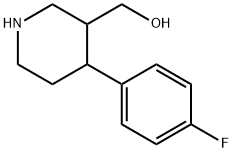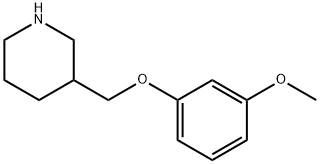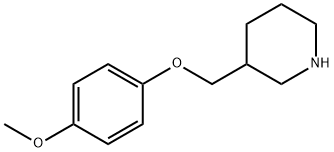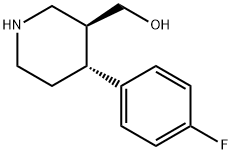N-Methylparoxetine
Synonym(s):(3S-trans)-3-[(1,3-Benzodioxol-5-yloxy)methyl]-4-(4-fluorophenyl)-1-methylpiperidine;N-Methylparoxetine
- CAS NO.:110429-36-2
- Empirical Formula: C20H22FNO3
- Molecular Weight: 343.39
- MDL number: MFCD03788781
- EINECS: 1312995-182-4
- SAFETY DATA SHEET (SDS)
- Update Date: 2025-09-02 17:37:48

What is N-Methylparoxetine?
Chemical properties
Off-White Solid
The Uses of N-Methylparoxetine
A drug impurity of Paroxetin, a selective serotonin reuptake inhibitor.
The Uses of N-Methylparoxetine
A drug impurity of Paroxetin, a selective serotonin reuptake inhibitor. Paroxetine USP Related Compound F.
Definition
ChEBI: N-methylparoxetine is a member of the class of benzodioxoles that is paroxetine in which the piperidine hydrogen is substituted by a methyl group. It is a drug impurity of the antidepressant, paroxetine. It has a role as an apoptosis inducer, a serotonin uptake inhibitor and an impurity. It is a member of benzodioxoles, an aromatic ether, a member of piperidines, a tertiary amino compound and a member of monofluorobenzenes. It is functionally related to a paroxetine.
Properties of N-Methylparoxetine
| Melting point: | 109.0 to 113.0 °C |
| Boiling point: | 443.7±45.0 °C(Predicted) |
| Density | 1.198±0.06 g/cm3(Predicted) |
| storage temp. | Hygroscopic, -20°C Freezer, Under Inert Atmosphere |
| solubility | Chloroform (Slightly), Methanol (Slightly) |
| form | neat |
| pka | 8.48±0.20(Predicted) |
| color | Off-White to Pale Yellow |
| BRN | 7468178 |
| CAS DataBase Reference | 110429-36-2(CAS DataBase Reference) |
Safety information for N-Methylparoxetine
| Signal word | Danger |
| Pictogram(s) |
 Skull and Crossbones Acute Toxicity GHS06  Environment GHS09 |
| GHS Hazard Statements |
H301:Acute toxicity,oral H410:Hazardous to the aquatic environment, long-term hazard |
| Precautionary Statement Codes |
P264:Wash hands thoroughly after handling. P264:Wash skin thouroughly after handling. P270:Do not eat, drink or smoke when using this product. P273:Avoid release to the environment. P391:Collect spillage. Hazardous to the aquatic environment P301+P310:IF SWALLOWED: Immediately call a POISON CENTER or doctor/physician. P405:Store locked up. |
Computed Descriptors for N-Methylparoxetine
N-Methylparoxetine manufacturer
Clickchem Research LLP
2Y
Phone:+91-8140031133
Whatsapp: +91- 8140031133
product: PAROXETINE USP RELATED COMPOUND F 110429-36-2 90 % Above
New Products
4,4-Difluoropiperidine hydrochloride tert-butyl 9-methoxy-3-azaspiro[5.5]undecane-3-carboxylate Indole Methyl Resin N-Isopropylurea N,N-Dicyclohexylcarbodiimide(DCC) MELDRUMS ACID 5-METHYLISOXAZOLE-4-CARBOXYLIC ACID Magnessium Bis glycinate Zinc ascorbate 1-bromo-2-butyne 2-acetamidophenol 9(10H)-anthracenone Erythrosin B, 4-Piperidinopiperidine 2-((4-morpholinophenylamino) (methylthio) methylene) malononitrile 2,4-dihydroxybenzaldehyde 3-(4-morpholinophenylamino)-5-amino-1H-pyrazole-4-carbonitrile Methyl 2-methylquinoline-6-carboxylate 2,6-dichloro-4-nitropyridine 4-Bromo-2-chlorobenzonitrile 2-(benzylamino)acetic acid hydrochloride 4-(tert-Butoxycarbonylamino)but- 2-ynoic acid 3,4-dihydro-2H-benzo[b][1,4]dioxepine 1-Phenyl-1-cycloprppanecarboxylicacidRelated products of tetrahydrofuran








You may like
-
 110429-36-2 98%View Details
110429-36-2 98%View Details
110429-36-2 -
 N-Methyl Paroxetine CAS 110429-36-2View Details
N-Methyl Paroxetine CAS 110429-36-2View Details
110429-36-2 -
 Paroxetine Related Compound F 98.00% CAS 110429-36-2View Details
Paroxetine Related Compound F 98.00% CAS 110429-36-2View Details
110429-36-2 -
 N-Methylparoxetine 98.00% CAS 110429-36-2View Details
N-Methylparoxetine 98.00% CAS 110429-36-2View Details
110429-36-2 -
 Paroxetine Related Compound F CAS 110429-36-2View Details
Paroxetine Related Compound F CAS 110429-36-2View Details
110429-36-2 -
 Paroxetine Related Compound F CAS 110429-36-2View Details
Paroxetine Related Compound F CAS 110429-36-2View Details
110429-36-2 -
 PAROXETINE USP RELATED COMPOUND F 110429-36-2 90 % AboveView Details
PAROXETINE USP RELATED COMPOUND F 110429-36-2 90 % AboveView Details
110429-36-2 -
 20677-73-0 (2,2-diethoxyethyl)methylamine 98%View Details
20677-73-0 (2,2-diethoxyethyl)methylamine 98%View Details
20677-73-0
Statement: All products displayed on this website are only used for non medical purposes such as industrial applications or scientific research, and cannot be used for clinical diagnosis or treatment of humans or animals. They are not medicinal or edible.
